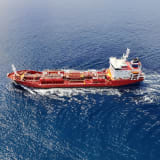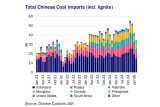
17th October 2023 – Market participants will be keenly watching the development of events on Thursday (19 October), when members of Offshore Alliance (OA) – a partnership between the Australian Workers’ Union and the Maritime Union of Australia – are poised to restart Protected Industrial Action (PIA) at the 15.6mtpa Gorgon and 8.9mtpa Wheatstone LNG projects in Australia amid ongoing disagreements with project operator Chevron.
The duration of the PIA, which will involve “work stoppages and partial work bans” at the facilities, is unclear. A one-week full outage at both the three-train Gorgon and two-train Wheatstone projects is equivalent to a loss of 469,863t of LNG, or 7-8 LNG cargoes, assuming a 65,000t cargo size.
“We can … confirm we have received Notices of Intention to take Protected Industrial Action at our Gorgon and Wheatstone facilities for work stoppages and partial work bans commencing 19 October 2023,” a Chevron spokesperson told SSY on 9 October. He told SSY in an update on 15 October that “yesterday (Oct 14) the unions advised that members have voted not to cancel the action planned for 19 October”, despite a “strong recommendation” from the Fair Work Commission (FWC) to withdraw the PIA. The FWC is an independent Australian workplace relations tribunal.
The resumption of PIA at the facilities was voted on by OA workers on 5-6 October and again late last week amid unresolved issues between OA and Chevron pertaining to the finalisation of Enterprise Bargaining Agreements (EBAs) covering workers at the Gorgon and Wheatstone facilities. EBAs are legal documents negotiated between employers, employees and bargaining representatives to establish fair employment conditions and wages.
OA workers had started taking PIA at Gorgon and Wheatstone on 8 September due to unhappiness with various terms of their employment, including remuneration, working hours and training entitlements. But they agreed to suspend PIA, which then involved work stoppages and partial work bans, on 21-22 September after Chevron and OA agreed to recommendations raised by the FWC in the Commission’s bid to resolve the conflict between the two parties. FWC’s recommendations included increased remuneration, job security, locked-in rosters, career progression, and returning all employees to a 40% roster.
However, OA recently claimed that Chevron had reneged on the commitment it had given the FWC to incorporate its recommendations into the EBAs covering workers at the projects. “The Offshore Alliance has been working with Chevron to finalise the drafting of the agreements. [However], as part of that process lawyers acting for Chevron have been attempting to walk back some clauses previously settled,” an OA spokesperson told SSY on 6 October.
“Members have made it clear that they want Chevron to stop twisting the draft terms of our EBA’s and are prepared to ramp up PIA until our EBA’s are properly sorted,” OA said in an update on 15 October. “The Offshore Alliance is fed up with the games Chevron and their lawyers are playing.”
But, Chevron told SSY on 15 October that it had participated in the discussions with the FWC and unions “in a genuine and meaningful way” and “accepted every clarification provided by the Commissioner on the small number of items in his Recommendation that the parties interpret differently”. Those differently interpreted items include allowance and reimbursements, accommodation and flights for training, as well as cabin sharing for Wheatstone platform members.
“Conversely, the unions have continued to add matters into dispute and are now withholding agreements on other matters on the basis that they do not have instruction from members, despite holding mass meetings with members on October 13 and 14,” the Chevron spokesperson said on 15 October, adding that the unions’ decision to ignore the recommendation to withdraw the PIA while discussions are ongoing is “very concerning [and] unreasonable”.
Uncertainty looms on impact of potential strikes
Market participants will be keeping an eye on the scope of the PIA when it begins on 19 October, as well as the impact it will have on market supply and prices, particularly heading into the peak demand northern hemisphere winter season.
The earlier 14-15-day PIA had limited impact on the projects’ operations and production; a Chevron spokesperson had told SSY on 20 September – in the midst of the PIA – that both plants were running at full rates. A total of 20 vessels loaded at Gorgon in September – including 11 vessels during the PIA from 8-22 September – just slightly below the 23 vessels loaded in August, before the PIA happened, according to vessel tracking site Kpler. Similarly, a total of 12 vessels loaded at Wheatstone in September, including six during the PIA, roughly similar to the 13 vessels loaded in August, Kpler data showed.
OA, as well as market participants, had claimed then that Chevron was using non-unionised contractors to replace striking workers, hence limiting the impact to production.
Chevron did not comment directly on the allegation, only saying: “Our focus is on maintaining safe and reliable operations in the event of disruption, and we will continue to manage the range of uncertainties that industrial action may present. Having appropriately qualified personnel available to maintain safe and reliable operations is one step we have taken to minimise disruption at our facilities.”
Some market participants expect a similar outcome should PIA proceed this time, but uncertainty remains. “We will take steps to maintain safe and reliable operations in the event of disruption at our facilities,” the Chevron spokesperson told SSY on 16 October, when asked about whether the company would use non-unionised workers to replace potentially lost manpower during the upcoming planned strikes.
By Kyla Schliebs, Head of LNG Research, SSY and Joey Chua, Market and Data Analyst, LNG, SSY
Articles
You may also be
interested in
View allGet in touch
Contact us today to find out how our expert team can support your business













